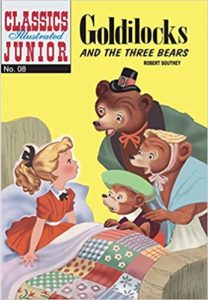There are few of us who cannot recall the wonderful fairy tales that were part of our childhood… time spent on a parent or grandparent’s comfy lap, or perhaps in a library group with a caregiver, listening to the magical words and enjoying the familiar illustrations that made up so many hours of our earliest years.
So now that you are a parent, just what can you do to enhance your time reading fairytales with your little one? In addition to the cozy one-on-one bonding, is there any real “education” to be gained from this reading time together? You bet! Aside from the soothing rhythm of the words, and the phonological awareness that is born of exposure to language, listening and interacting, the structure of the fairy tale in particular, lends itself to a particular Comprehension Strategy that will serve your child later, both in school, and in his personal enjoyment of literature.
Specifically, fairy tales fall into the category that we reading specialists call “Narrative Text.” This type of literature can be easily understood by using the Comprehension Strategy of “Story Grammar.” As a work of fiction, it generally follows a predictable format that includes the following 5 “Story Elements”:
1. “Characters” (most often a main character, in addition to others)
2. the “Plot”(the story line)
3. the “Problem” (the conflict, or rising issue)
4. the “Turning Point” (when there is action that changes the course of events and leads to the…)
5. the “Resolution,” or Solution to the story’s conflict
Keeping this “Story Grammar” in mind, as you read narrative stories with your child, it is a good idea to visit these 5 key concepts. For your youngest readers, you may do this in a very simple way, using simple language; for your older readers, you could begin to introduce the terms as they are written above. Your children will certainly hear them again in school through the elementary and middle school grades, and having previewed “Story Grammar” with you, identifying the character(s), the plot, the problem, the turning point, and the resolution, your child will already be familiar with the concept when they hear it in school. Research has shown that “previewing” is far more effective than “reviewing” when it comes to receptivity to learning, and long-term retention of information.
You might also take a look at an earlier blog entitled “Thinking Cards,” for an idea for a game that you and your child might play while reading narrative text to reinforce the concept of “Story Grammar.”
Another idea that you might use aside from simply talking about the parts of narrative text, is to have your child draw pictures for each of the 5 story elements, perhaps on a labeled outline of a puzzle piece. Once they have drawn and/or colored in a puzzle piece for each of the individual story elements, you can show them how each piece of the puzzle fits together to make the whole story!
Here is a list of some classic and wonderful fairytales from around the world that you and your child might enjoy. You will notice the familiar titles; Americans take many of their fairytales from England, France and Germany. But there are others…
| NAME OF FAIRYTALE | AUTHOR/REGION | YEAR WRITTEN |
| Cinderella | Charles Perault/France | 1697 |
| Beauty and the Beast | Gabrielle-Suzanne Barbot de Villneuve | 1740 |
| Goldilocks and the Three Bears | Robert Southey/England | 1837 |
| Hansel and Gretel | Brothers Grimm/German | 1812 |
| Little Red Riding Hood | Charles Perault/France | 1695 |
| Snow White and the Seven Dwarfs | Brothers Grimm/German | 1823 |
| Jack and the Beanstalk | Joseph Jacobs/England | 1890 |
| Sleeping Beauty | Charles Perault/France | 1697 |
| Puss in Boots | Charles Perault/France | 1697 |
| Rapunzel | Brothers Grimm/German | 1812 |
| Sinbad the Sailor | unknown/Saudi Arabia | before 850 |
| Snow White | Brothers Grimm/Germany | 1823 |
| Strega Nona | Tomie dePaola/Italy | 1975 |
| The Ugly Ducking | Hans Christian Andersen/Denmark | 1843 |
| Thumbelina | Hans Christian Andersen/Denmark | 1846 |
| The Gingerbread Man | Joseph Jacobs/England | 1890 |
| The Little Red Hen | unknown/Russia/England ? | 1899 |
| The Stolen Bride | Lady Francesca Speranza Wilde/Ireland | 1888 |
| The Story of Pretty Goldilocks | Madame d’Aulnoy/France | 1698 |
| The Lazy Wife | Sophia Morrison/Isle of Man | 1911 |
| The Three Aunts | Peter Christian Asbjørnsen&Jørgen Moe/Norway | 1845 |
| The Three Crowns | Giambattista Basile/Italy | 1634 |
| The Wishing Stone | Barry O’Connor/Ireland | 1890 |
| The Wolf Maids | Michael Scott/Ireland | 1989 |
| The Changeling | Thomas Crofton Croker/Ireland | 1825 |
| Three Billy Goats Gruff | Peter Christian Asbjørnsen&Jørgen Moe/Norway | 1845 |
| Tom Thumb | Richard Johnson/England | 1621 |
The Rabbi Arthur Schneier Park East Day School is a prestigious NYC Jewish Day School in the heart of New York City. Located in the Upper East Side, this Jewish Day School promotes academic growth through community and collaboration.
